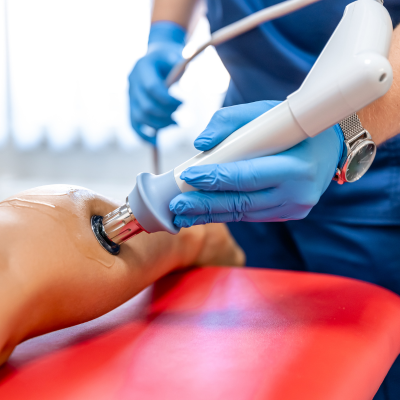
Physiotherapy has always been the preferred choice when it comes to dealing with musculoskeletal pain and injuries. Traditional physiotherapy treatments, ranging from manual therapy to exercise programs, have helped millions of patients over the years regain movement and reduce pain. But in recent years, there has been a revolution in treatment using shockwave therapy, an innovative non-invasive therapy to promote healing and relieve pain when nothing else seems to work. At Dixie Physiotherapy & Wellness, we integrate both approaches to put together the most successful rehabilitation programs for our patients.
What is Shockwave Therapy?
It’s one of the most effective non-invasive treatments available, harnessing high-energy sound waves to trigger repair in painful and damaged tissues, tendons, ligaments and muscles. It boosts blood circulation, encourages the production of collagen and breaks down scar tissue. This makes it particularly good for chronic problems, such as:
- Plantar fasciitis
- Tennis or golfer’s elbow
- Achilles tendonitis
- Rotator cuff injuries
- Chronic joint pain
Shockwave therapy is frequently capable of achieving faster results than traditional treatment options as it addresses the cause of the problem and stimulates the body’s natural healing process.
What are Traditional Physiotherapy Treatments?
Conventional physical therapy is a generalized term which refers to different methods, including:
- Manual therapy: Hands-on procedures such as joint mobilizations or soft tissue massage.
- Rehabilitation: Individualized strengthening and stretching programs to regain function.
- Ultrasound or electrotherapy: Pain relief and circulatory fitness modalities.
- Education and correction: Instruction to enhance injury prevention.
These techniques have been proven over time and work well with both acute and chronic injuries. They specialize in mobility, pain reduction, and preventing re-injury through functional training.
The first key difference is in comparing how both therapies work.
Treatment Focus
- Shockwave Therapy: For chronic, recalcitrant conditions where the tissues are slow to heal.
- Physical therapy: Treats both new and old injuries with a comprehensive, sustainable approach.
Speed of Results
- Shockwave Therapy: Many patients see results after 3 to 5 sessions.
- Physical therapy: Results may be slow, and many therapy sessions might be needed for several weeks or months.
Approach to Healing
- Shockwave Therapy: A can-not-fail treatment that encourages cell regeneration and treats the aches.
- Physiotherapy: Strengthens muscles, increases flexibility and overall function to reduce recurrence.
Best Use Cases
- Shockwave: Established and is unresponsive to most other treatments.
- Physical Treatment: General rehabilitation, postoperative recovery, and recent injury care.
What Treatment do You Need?
The combination of both treatments is often best. Shockwave treatment accelerates the healing even of recalcitrant injuries, and conventional physio sets in to ensure a long-term recovery (through strength and movement changes). At Dixie Physiotherapy & Wellness, our staff are dedicated to creating treatment plans individualized for your needs, focusing on an equal commitment to advanced technologies and proven therapeutic solutions.
Final Thoughts
Whether you’re dealing with a longstanding injury or recently rehabbing one, there are benefits to both shockwave therapy and traditional physiotherapy. Selecting the right approach—or a combination thereof—can make all the difference in achieving pain relief that truly lasts as well as greatly enhanced mobility.
Take that step towards recovery -call Dixie Physiotherapy & Wellness now to book your appointment!



